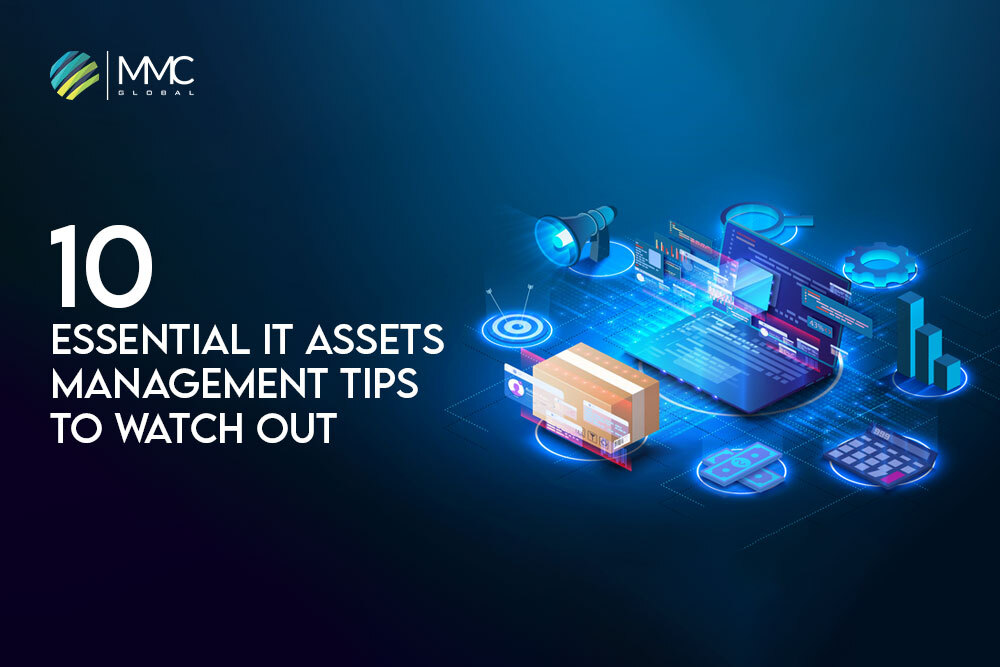IT Asset Management – 10 Essential Managing Tips To Watch Out


In the IT industry, the record of assets is as essential as your wealth. That is why the IT industry always looks upon proper IT asset management records and data while selling or buying IT devices and services.
The need for IT asset management is realized when we bear a great loss cost, such as missing devices, expired warranty claims, overdue licenses, etc. If you belong to the IT industry, you must face these issues if you do not have a proper IT asset management solution.
Additionally, people mostly go for software development to manage IT assets that help automate the whole asset management process. As a part of the software development industry, MMC Global also owns a number of clients who need IT asset management software to manage their bulk hardware supplies, such as laptops, mobile devices, accessories, etc.
We build customized IT asset management software solutions that fulfill the needs of our clients. Moreover, adding features that enhance the functionality of the software is not a big deal for our developers. You can see our portfolio to know the worth of our projects.

The Need for IT Asset Management Software
By definition, IT asset management software deals with the incoming and outgoing IT assets you have been selling to customers and buying from vendors. Moreover, the requirement of IT asset management starts with keeping accurate records, eliminating unnecessary purchases, controlling cost and purchasing, and providing security throughout the IT asset lifespan.
Read More: Why Asset Management Software is Important in Modern Business?
Managing IT assets can be improved by taking unintrusive practices to organize your IT assets. Let’s have a look.
10 Tips Practices to Smooth your Asset Management
Develop a Comprehensive Inventory
Start by creating an inventory of all your IT assets, including hardware, software, and networking equipment. This will help you keep track of what you have and identify any gaps in your asset management strategy. Meanwhile, you can create a useful list of meaningful and most wanted inventories in demand, and people actually ask for more than other products.
Establish Clear Ownership
Assign ownership of each IT asset to a specific person or team. This will help ensure that someone is responsible for maintaining and updating the asset, as well as making sure of the proper utilization over time. Those who own the assets will be responsible for creating a clear record with the help of IT service management software and accessible whenever required.
Define a Standard Naming Convention
Use a standard naming convention for all your IT assets. It will make it easier to identify and track assets across your organization. You can note all information from receiving to the delivery location using functional IT asset management software. Consequently, you can manage external and internal dealings that include vendors, customers, and your managing team.
Set up a System for Tracking Changes
Implement a system for tracking changes to your IT assets, such as when new software is installed, or hardware is added or removed. It will help you keep your inventory up-to-date and ensure an accurate picture of your IT environment. Moreover, companies regularly pick a bulk order to restock items, and it is frustrating if they need to add manual entries on a regular basis. IT asset management software can automate these repetitive tasks per your routine operations.
Monitor and Manage Software Licenses
Keep track of all software licenses and ensure that you comply with licensing agreements. It will avoid costly fines and penalties against you. The record of software licensing allows sellers to provide authentic software or hardware ownership so that the end-user gets the trusted services from your end.
Create a Maintenance Schedule
Every industry wants to provide excellent support and maintenance services so that the existing customer remains and the new ones come more often. To ensure this, IT asset management allows you to create a maintenance schedule so that you never forget to deliver an exceptional customer experience. Develop a schedule for routine maintenance tasks, such as software updates and hardware checks. Moreover, it will ensure that your IT assets are running smoothly and minimize the risk of downtime.
Conduct Regular Audits
Conduct regular audits of your IT assets to ensure they are used properly and in good working condition. It identifies issues early on and addresses them before they become bigger problems. IT management software lets you line up regular audits and get personalized notifications whenever the audit date arrives. You can customize all notifications at your convenience.
Keep Documentation Up-to-Date
Maintain up-to-date documentation of all your IT assets, including user manuals, warranty information, and configuration details. Moreover, it addresses troubleshooting issues and ensures you can quickly recover from downtime.
Automate Performance Checks
You can not oversee each and every asset’s durability and performance. Either train your employees on proper asset management and maintenance or automate it with IT asset management software. It allows your IT assets to be used effectively, and your organization gets the most value out of them.
Continuously Review and Improve
Continuously review and improve your IT asset management strategy to keep everything streamlined. It stays up-to-date with new technologies and ensures you get the most out of your IT investments.
Bottom Line
Every business that belongs to the IT industry needs to manage and control its assets effectively with less cost. Implementing IT asset management software is a good idea to make your entries accurate, take breaks from repeated tasks, reduce workload, and even cut additional costs.
If you are looking for a long-term partner to build functional software for your IT asset management, you can rely on MMC Global’s professional software development team. Don’t hesitate to connect with us!



